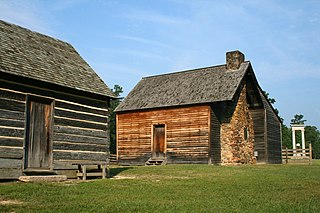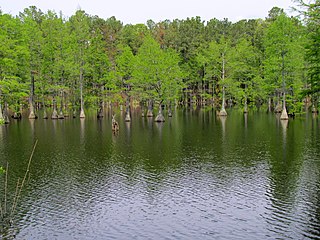Green Level is an unincorporated community in southwestern Wake County, North Carolina, United States. It was founded c. 1800 and is one of the best preserved crossroads communities in the county. Although historically connected to the town of Apex, Green Level now lies within the municipal jurisdiction of the town of Cary.

James Buchanan Duke was an American tobacco and electric power industrialist best known for the invention of modern cigarette manufacture and marketing techniques, and his involvement with Duke University. He was the founder of the American Tobacco Company in 1890.

Shirley Plantation is an estate on the north bank of the James River in Charles City County, Virginia. It is located on scenic byway State Route 5, between Richmond and Williamsburg. It is the oldest active plantation in Virginia, settled in 1613 and is also the oldest family-owned business in North America, when it was acquired by the Hill family, with operations starting in 1638. White indentured servants were initially used as the main labor force until the early 1700s, when black slavery became the primary source of Virginian labor. It used about 70 to 90 African slaves at a time for plowing the fields, cleaning, childcare, and cooking. It was added to the National Register in 1969 and declared a National Historic Landmark in 1970. After the acquisition, rebranding, and merger of Tuttle Farm in Dover, New Hampshire, Shirley Plantation received the title of the oldest business continuously operating in the United States.

Horne Creek Farm is a historical farm near Pinnacle, Surry County, North Carolina. The farm is a North Carolina State Historic Site that belongs to the North Carolina Department of Natural and Cultural Resources, and it is operated to depict farm life in the northwest Piedmont area c. 1900. The historic site includes the late 19th century Hauser Farmhouse, which has been furnished to reflect the 1900-1910 era, along with other supporting structures. The farm raised animal breeds that were common in the early 20th century. The site also includes the Southern Heritage Apple Orchard, which preserves about 800 trees of about 400 heritage apple varieties. A visitor center includes exhibits, a gift shop and offices.

Bennett Place is a former farm and homestead in Durham, North Carolina, which was the site of the last surrender of a major Confederate army in the American Civil War, when Joseph E. Johnston surrendered to William T. Sherman. The first meeting saw Sherman agreeing to certain political demands by the Confederates, which were promptly rejected by the Union cabinet in Washington. Another meeting had to be held to agree on military terms only, in line with Robert E. Lee’s recent surrender to Ulysses S. Grant. This effectively ended the war.

The Cedarock Historical Farm, located at Cedarock Park in Alamance County, North Carolina, provides an example of life on a farm in North Carolina during the 19th Century. Populated with farm animals, antique and replica farm equipment, and a farmhouse, the Historical Farm provides a fun, education stop while visiting Cedarock Park.

The Oconaluftee is the valley of the Oconaluftee River in the Great Smoky Mountains of North Carolina. Formerly the site of a Cherokee village and an Appalachian community, the valley is now North Carolina's main entrance to Great Smoky Mountains National Park.

Cleveland Township is one of fourteen non-functioning county subdivisions (townships) in Rowan County, North Carolina that were established in 1868. The township had a population of 2,817 according to the 2010 census. The only incorporated municipality in Cleveland Township is the town of Cleveland. Residents are served by the Rowan–Salisbury School System and the township is home to Mt Ulla Elementary School.

Oaky Grove is a historic house located in Shotwell, Wake County, North Carolina, a suburb of Raleigh. Built in 1818 by Thomas Price, Oaky Grove has been home to generations of the Price, Blake, and Doub families. Before the Civil War, the Price plantation consisted of 4,500 acres (1,800 ha) of farm land. Today, the 28-acre (11 ha) property is owned by the Doubs family and contains the two-story Federal style home, a smokehouse, barn, and the family cemetery.

Carvers Creek State Park is a North Carolina state park in Cumberland County, North Carolina in the United States. Located north of Fayetteville, it covers 4,530 acres (18.3 km2) in the Sandhills region of the state. The park covers lands around Carvers Creek, a tributary of the Cape Fear River, and it borders Fort Bragg. The park is currently divided into two areas, Long Valley Farm and the Sandhills Property. The park is still being planned, and the state is planning to acquire more land for the park.

The Capt. Thomas Morse Farm is a historic farmhouse on Old Marlborough Road in Dublin, New Hampshire. It is a small 1+1⁄2-story two-room cottage, similar to other early period Cape style farmhouses in the town and probably built in the late 18th century by one of the town's first settlers. Now a clubhouse for the Dublin Lake Golf Club, it is one of the few buildings from that period to survive. The house was listed on the National Register of Historic Places in 1983. It appears to have been torn down and replaced by a more modern structure.

Alphonse Calhoun Avery House, also known as the Avery-Surnrnersette House, is a historic home located at Morganton, Burke County, North Carolina. It was built about 1876, and is a two-story, U-shaped, Late Victorian style brick house. It features a 2+1⁄2-story, squarish, brick tower topped by a mansard roof.
Long Valley Farm is a historic farm and national historic district located in Carvers Creek State Park near Spring Lake in Cumberland County and Harnett County, North Carolina. It encompasses 24 contributing buildings and 5 contributing structures on a winter agricultural estate. The main house is known as the Long Valley Farm Seat, or James Stillman Rockefeller Residence, and was built in 1937–1938. It is a two-story, five-bay, Colonial Revival style frame dwelling with one-story wings. Other notable contributing resources are the Mill Pavilion, Mill House and Gates, Pack House, Forge, Great Barn, Overseer's House, Tobacco Barns, Worker's Houses, Springhouse, and Water Tower. Noted financier James Stillman Rockefeller become the full owner of Long Valley Farm in January 1937.
Thomas Sheppard Farm, also known as Sheppard Mill Farm, is a historic home and farm located near Stokes, Pitt County, North Carolina. The farmhouse was built about 1850, and is a two-story, heavy timber frame dwelling with a one-story shed addition and Greek Revival style design elements. A one-story kitchen wing constructed about 1930, and was enlarged and joined to the main block about 1950. It features a one-story portico with Doric order columns. Also on the property are the contributing tenant house, stock barn, tobacco barn, hog pen, chicken house, brick well house, and agricultural landscape.
Barber Farm, also known as Luckland, is a historic farm complex and national historic district located near Cleveland, Rowan County, North Carolina. The Jacob Barber House was built about 1855, and is a two-story, single-pile, three-bay vernacular Greek Revival style frame dwelling. It has a one-story rear ell and a one-story shed roofed rear porch. Its builder James Graham also built the Robert Knox House and the Hall Family House. Other contributing resources are the cow barn, smokehouse, granary, double crib log barn, well house, log corn crib / barn, carriage house, school, Edward W. Barber House (1870s), Edward W. Barber Well House (1870s), North Carolina Midland Railroad Right-of-Way, and the agricultural landscape.
Knox Farm Historic District is a historic farm complex and national historic district located near Cleveland, Rowan County, North Carolina. The Robert Knox House was built between 1854 and 1856, and is a two-story, single-pile, three-bay vernacular Greek Revival style frame dwelling. It has a two-story rear ell, one-story rear kitchen ell. Its builder James Graham also built the Jacob Barber House and the Hall Family House. Other contributing resources are the log corn crib, reaper shed, power plan, chicken house, brooder house, log smokehouse, barn, main barn (1916), milking parlor (1948), spring house, tenant house (1920), and Knox Chapel Methodist Church (1870s).
Marcheston Killett Farm is a historic home and farm near Clinton, Sampson County, North Carolina. The house was built about 1865 and is a large one-story, double-pile, Greek Revival style frame dwelling sheathed in weatherboard. It has a cross-gable roof, a rear ell with a formerly separate log kitchen incorporated, and a dominant front, pedimented, central porch. The interior is center-hall in plan. Also on the property are the contributing sites of demolished outbuildings.
Livingston Oates Farm is a historic home and farm located near Clinton, Sampson County, North Carolina. The house was built about 1875, and is a one-story, double pile, Greek Revival style frame dwelling. It has a cross gable roof, rear ell, brick pier foundation, and a dominant front, pedimented, central porch. The interior is center-hall in plan. Also on the property are the contributing commissary, center aisle barn and stable, packhouse, an early gas pump, root cellar, tractor shed, and family cemetery.
Hollingsworth–Hines Farm is a historic home and farm complex and national historic district located near Turkey, Sampson County, North Carolina. The house was built between 1785 and 1800, and is a two-story, log dwelling with a later rear ell. Also on the property are a number of contributing farm outbuildings, most notable are two log smokehouses, the large six stall barn, two handsome packhouses, a very unusual arrangement of three connected tobacco barns and the family cemetery.

Shaw Family Farms are historic family farms and a national historic district located near Wagram, Scotland County, North Carolina. The district encompasses 16 contributing buildings and 2 contributing structures. They include three houses: The Dr. Daniel Shaw House, a large two-story, double-pile house with a dominant double tier gable portico built about 1885 with a Greek Revival interior; the Alexander Edwin Shaw House, a rambling one-story vernacular frame dwelling with an extensive Victorian wraparound porch also built about 1885; and the Dr. William Graham Shaw House, a one-story house of traditional local form, treated with a variety of simplified Queen Anne elements and built in 1900. Also on the farms are a number of contributing agricultural outbuildings.















